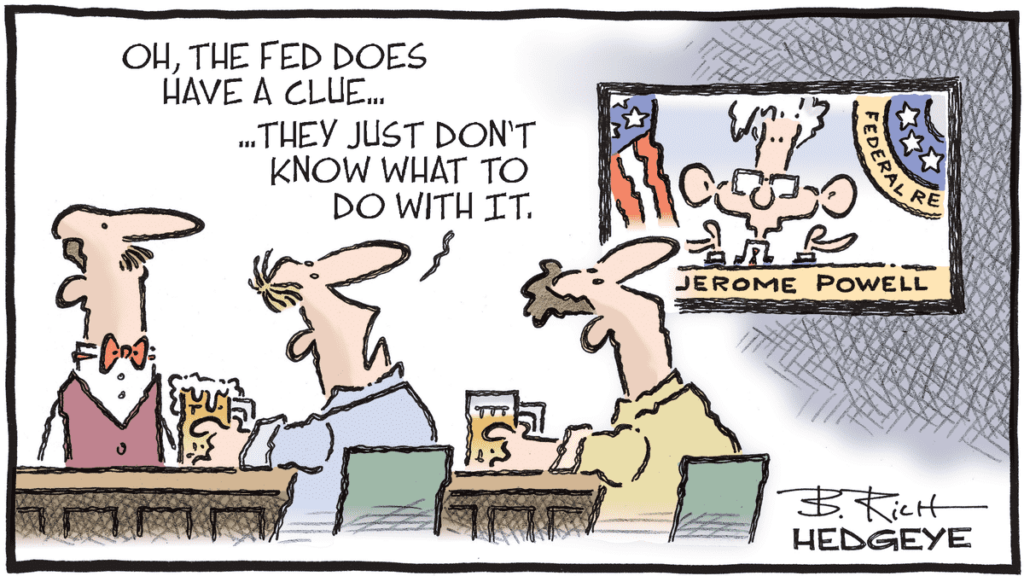
I just went through the latest news from last night and Sunday evening, and it seems that Trump has refrained from making any sharp statements for over 48 hours. At least, no statements that could impact the markets or drag us underwater as we start the week—something we’ve gotten used to since the American President took office. So, we should begin the week on the same footing as the end of last week, hoping that the worst is behind us and, most importantly, that after the storm comes the calm!
Nothing Changes
Technically, the markets are still highly oversold, and we remain in critical zones. For now, it looks like we’ve limited the damage, and in the grand scheme of things, we’re not that far from all-time highs. It wouldn’t take much for the market outlook to shift from storm warnings to clear blue skies. However, the same issues that got us here are still present and remain a serious thorn in our side. TARIFFS are our main concern—and will likely remain so for quite some time. In early April, Trump is expected to implement reciprocal tariffs with several countries, but there’s still a lot of uncertainty. So far, trade issues haven’t been resolved, whether with Europe, Canada, China, or Mexico. In short, we keep talking about it, but given the lack of clarity—not just regarding their implementation but also the possibility of them being lifted, reduced, increased, or modified—we’re left in the dark. This is what we call UNCERTAINTY, and apart from discussing it every morning, there’s not much hope for clarity anytime soon.
The good news is that, “for now,” we seem to have “digested” the situation. As long as the White House doesn’t announce exceptional tariffs on French camembert exports, things might not get worse. Looking at analysts and strategists, expectations for the year have already been lowered, but at the same time, we’re not plunging into an economic abyss. Last week, we did hear some positive news regarding artificial intelligence—take Micron’s quarterly numbers, confirming the sector’s boom. That said, this optimism hasn’t been reflected in the behavior of the Magnificent Seven, particularly Nvidia, as investors remain cautious about the tech sector. We know that at these levels, it’s a great opportunity to reinvest, but for now, risk appetite remains moderate.
Confidence—or Lack Thereof
While the bleeding has stopped, the rebound has been about as dynamic as an overcooked spaghetti noodle left in boiling water for a week. We need a clear confirmation of this rebound, not this sluggish movement we’ve been witnessing over the past three or four days. The first real test for any meaningful recovery may come from the U.S. consumer confidence data set to be released Tuesday evening. After all, American growth is nothing but a myth if the average American isn’t spending their evenings shopping on Amazon—mostly buying useless things. Lately, however, enthusiasm seems to be fading, with consumers opting to browse Vinted rather than the Apple Store to splurge on two new MacBooks and three iPhones.
We saw and heard it last week: FedEx isn’t optimistic about the future, and Nike hinted that “this year won’t be easy.” These statements suggest that consumer spending is slowing down, and when that happens, American growth suffers—and the worst-case scenario looms. However, tomorrow’s consumer confidence data will either reassure us or sink us further. If the number disappoints, panic will set in, reminding us of recent reports suggesting that a potential recession could be on the horizon by summer. And I don’t need to explain what happens when people start seriously considering the arrival of a recession—scythe, black hood, and all.
Ironically, the only silver lining in this scenario would be if consumer spending slows down enough to help inflation retreat toward 2%—which, in that case, would be a blessing in disguise.

It’s for the end of the week
And inflation? We’ll talk about it at the end of the week since we’re in “PCE week,” and that’s when we’ll see if everything is falling into place in the right direction and whether we should conclude that this economic slowdown—driven by consumers and falling inflation—is the price to pay to allow Powell to cut rates AND restart the economy while Trump pockets cash with his tariffs. It’s still a bit early to make judgments or place bets on what’s next, but the numbers that will be our daily bread this week might give us a bit more clarity and add some extra pieces to the global financial puzzle.
I wouldn’t go so far as to say that the coming week is a “turning point,” but let’s just say that a few seemingly trivial figures could help us navigate our way out of this labyrinth of tariffs, interest rate wars, and the ongoing fight against inflation. The upcoming week will also be interesting from a geopolitical perspective, since last week’s discussions were limited, and the ceasefire between Russia and Ukraine is becoming more and more overdue. As for Gaza, we’ve apparently already forgotten how to spell the word “ceasefire.” In short, investors are filled with doubt, waiting for concrete proof before confirming a rebound—or completely deflating. Yes, because we must be very careful: in case of disappointment and a potential drop back to the March 15 lows, with a possible break below the 5,500 level on the S&P 500, we could find ourselves in what might well be called a “financial bloodbath.” But let’s not sell the bear’s skin before we’ve killed it. For now, futures indicate a grand opening on Wall Street, but if Trump set his alarm early on this penultimate Monday of March, let’s not forget that he has the ability to flip optimism on its head 22 times in a single day.
Asia and the Rest
This morning in Asia, absolutely nothing is happening. The three main regional indices are in total stagnation. If they were playing “Red Light, Green Light,” they’d be unbeatable. The Nikkei is unchanged, despite Japan’s Manufacturing and Services PMI indices contracting in March due to persistent headwinds related to trade and inflation. Meanwhile, the Hang Seng is slightly down by 0.12%, just like Shanghai, which is down 0.2%. In summary, it’s incredibly dull, and we’re waiting for more information to get a clearer picture. Nothing has changed in the past few days: we are drifting between tariffs, uncertainty, and confidence. At this moment, persistent rumors suggest that Trump’s tariffs, set to take effect on April 1st, “might” be less severe than expected. But once again, note the excessive and repeated use of the conditional tense—because, to be honest, we’re currently navigating in total fog, and it would be nice if it “lifted” a bit. It’s like skiing—nobody likes a whiteout.
Today’s News
As for today’s news, I had to double-check that it was actually Monday because there’s absolutely nothing to talk about. Noteworthy is that the Canadian Prime Minister wants to call early elections, and François Bayrou has reached 100 days as Prime Minister—proof that even miracles are possible in politics. You can be an utterly incompetent loser, burdened with so many scandals that even your scandals have scandals, and still manage to remain Prime Minister for 100 days. His technique? Ignoring criticism and turning a deaf ear to accusations. Meanwhile, the Pope has left the hospital. That should tell you just how little there is to say. When you’re forced to mention the Pope just to fill three lines in a column, you know it’s a slow news day.
Market Numbers
As for today’s figures, it’s PMI season. We’ll have Manufacturing PMI data from France, Germany, Europe, and the US, followed by the same reports for the services sector in those regions. Then, we’ll hear from the Fed’s Bostic and Barr, and tomorrow, we’ll discuss the psychological state of the consumer. Until then, we’ve had more exciting starts to the week.
Since it’s quiet, I’d like to take the opportunity to let you know that one of my partners, Bilan magazine, is organizing a conference titled “How Technology is Democratizing Youth Investment.” The event will take place at Uni Dufour in Geneva this Wednesday, March 26th, from 6:30 PM to 9:00 PM. I will be one of the participants in this conference. Admission is free, but it’s best to register. You’ll find the registration link below:
Conference on Youth, Money, and Technology
Looking forward to meeting you there. Until then, have an excellent Monday, and we’ll see you tomorrow for the next episode of this potentially exciting—or not—week.

